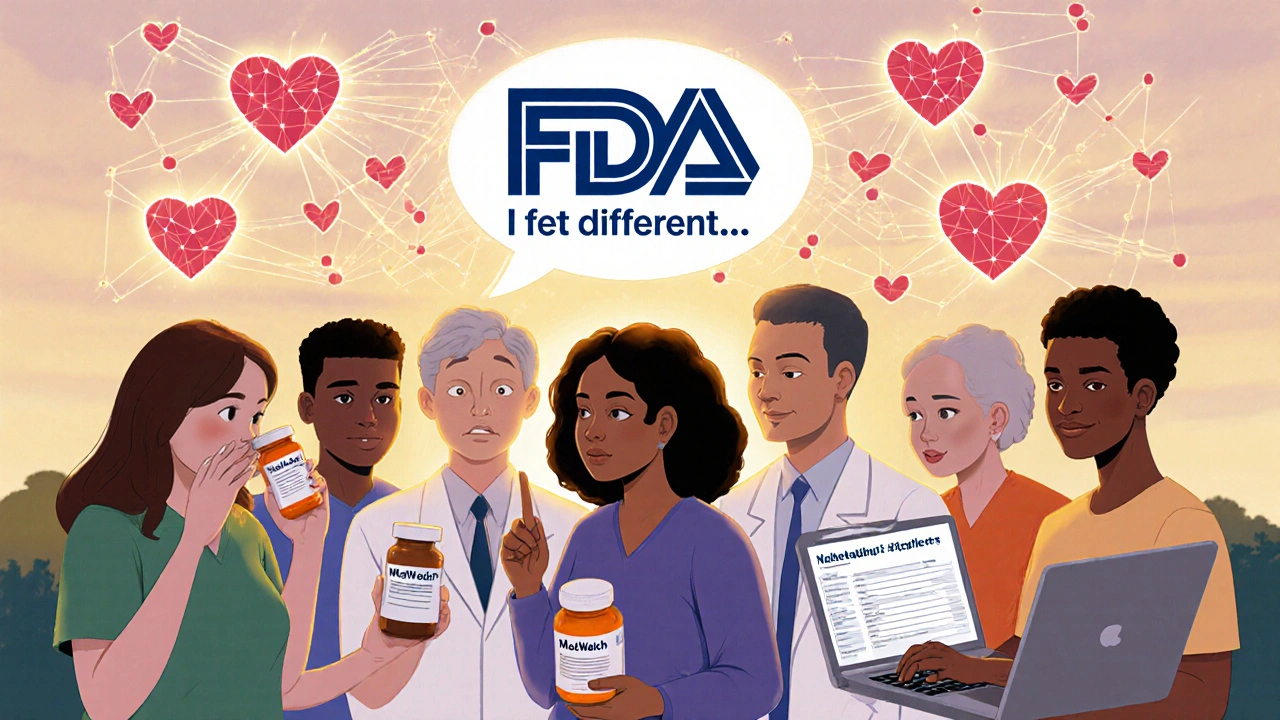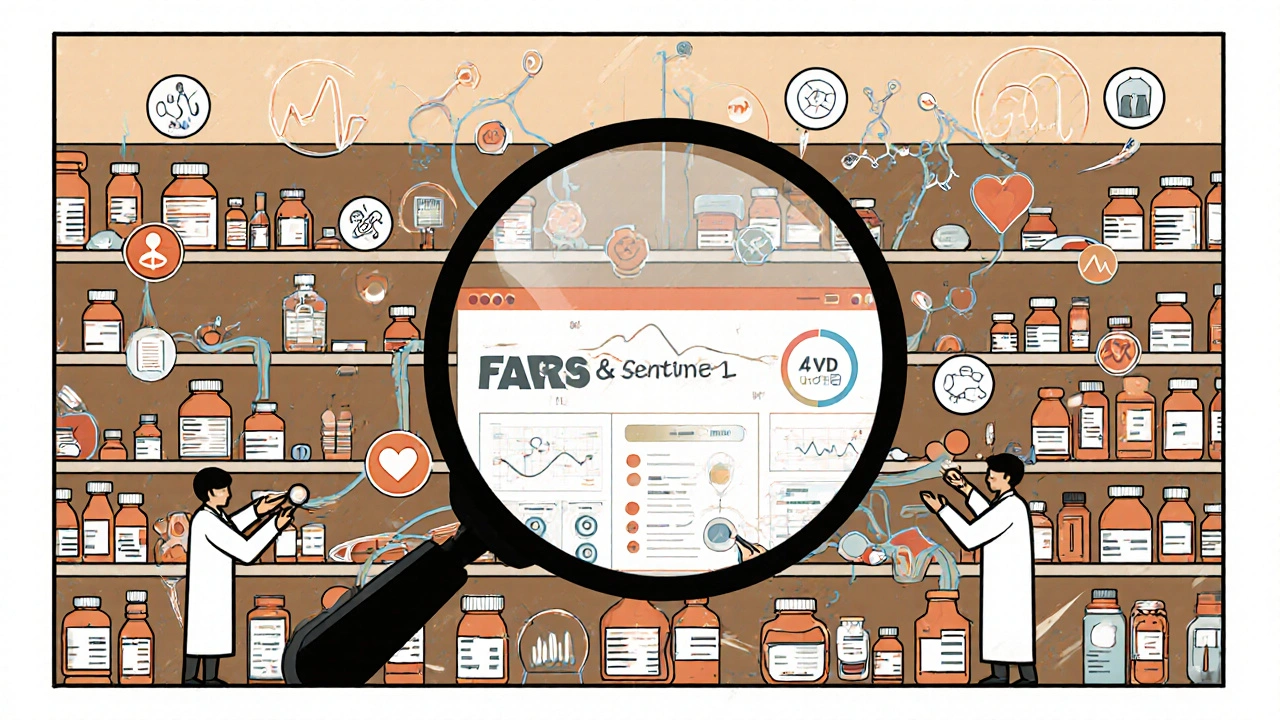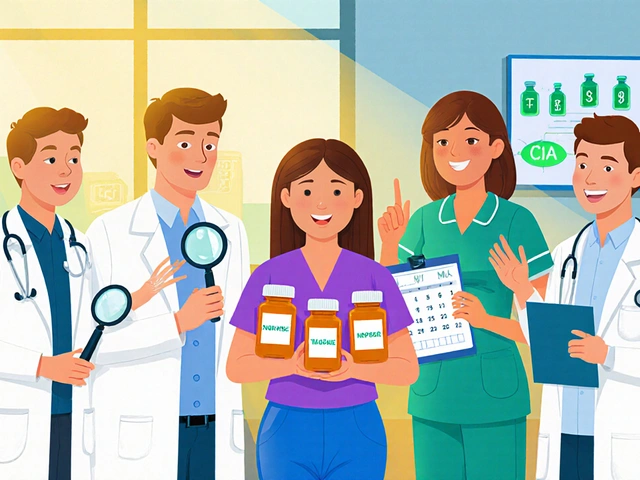Every day, millions of Americans take generic drugs. They’re cheaper, widely available, and just as effective as brand-name medicines-when they’re safe. But how do we know they stay safe after they hit the shelves? The FDA doesn’t just approve generic drugs and walk away. It runs one of the most complex drug safety systems in the world, watching for problems that only show up after thousands, even millions, of people have used them.
Why Generic Drugs Need Extra Monitoring
Generic drugs must prove they’re bioequivalent to the brand-name version. That means they deliver the same active ingredient at the same rate and amount. But bioequivalence studies? They’re done on 24 to 36 healthy volunteers. That’s not nearly enough to catch rare side effects, interactions in older patients, or reactions in people with multiple chronic conditions.Take a simple example: a generic version of a blood pressure pill. In clinical trials, it works just like the brand. But months later, a cluster of reports comes in from rural clinics: patients on the generic are getting dizzy, fainting, or having irregular heartbeats. The brand version? No such pattern. What changed? Maybe a different filler ingredient. Maybe a tiny impurity that slipped through. The FDA doesn’t wait for a crisis. It’s already looking.
The Systems That Watch Every Pill
The FDA doesn’t rely on luck or complaints alone. It runs multiple, overlapping systems to catch problems early.FAERS-the FDA Adverse Event Reporting System-is the backbone. It collects over 2 million reports a year from doctors, pharmacists, patients, and manufacturers. These aren’t just random notes. Trained scientists analyze them using algorithms that spot unusual patterns. If a certain generic version of metformin suddenly shows a spike in reports of lactic acidosis, FAERS flags it. That triggers a deeper dive.
The Sentinel Initiative is the FDA’s real-time radar. It taps into electronic health records from over 100 million patients across hospitals, clinics, and insurers. Instead of waiting for someone to file a report, Sentinel looks at actual patient outcomes. Did people on this generic version have more hospital visits for kidney issues? Did they need more lab tests? This system found hidden risks in some diabetes and cholesterol drugs years before traditional methods would have.
Manufacturing inspections are just as critical. The FDA does about 1,200 inspections of U.S. factories and 600 abroad each year. These aren’t scheduled announcements. Sometimes inspectors show up at 5 a.m. They check everything: where raw materials come from, how batches are mixed, whether lab tests are accurate. A single contaminated batch of generic metoprolol once caused heart rhythm problems in 15 states. It was caught because an inspector noticed the lab logs didn’t match the production records.

How the FDA Handles Red Flags
When something looks off, the FDA doesn’t panic. It investigates.The Office of Generic Drugs (OGD) has a dedicated Clinical Safety and Surveillance Committee. It meets every few weeks. Members include pharmacologists, chemists, and doctors who review every signal-from FAERS, Sentinel, manufacturer reports, or even scientific journals. They ask: Is this a fluke? A known side effect? Or something new tied to this specific generic?
If they find a real risk, they act. Here’s what that looks like:
- Label updates: A warning gets added to the package insert. For example, a generic thyroid drug was found to cause heart palpitations in elderly patients. The label now says: "Use with caution in patients with cardiovascular disease."
- Dear Healthcare Provider letters: The FDA sends direct alerts to doctors and pharmacists. In 2021, a generic version of the blood thinner apixaban was linked to increased bleeding in patients with kidney disease. Doctors got a letter telling them to check kidney function before prescribing.
- Voluntary recalls: If the risk is serious and widespread, the FDA pushes for a recall. In 2020, a batch of generic valsartan was pulled after a cancer-causing impurity was found. Over 100,000 bottles were recalled.
- Manufacturing shutdowns: If a factory repeatedly fails inspections, the FDA can block its products from entering the U.S. market. One Indian plant was banned in 2022 after repeated failures in testing raw materials.
Where the System Still Has Gaps
The FDA’s system is strong-but not perfect.One big problem? Underreporting. Experts estimate only 1% to 10% of adverse events are ever reported. A patient feels nauseous after switching to a generic. They don’t connect it to the drug. They don’t call their doctor. No one files a report. The FDA never sees it.
Another issue: complex generics. Inhalers, patches, injectables, and nasal sprays are harder to copy exactly. Even small differences in how the drug is delivered can change how it works in the body. The FDA has started focusing more on these, especially under GDUFA III (2023-2027), but tracking therapeutic equivalence in these products is still a challenge.
And then there’s the ingredient puzzle. Generics can use different inactive ingredients-fillers, dyes, preservatives. Most are harmless. But in rare cases, they trigger allergies or affect absorption. A 2021 study found that some generic versions of seizure medications had different dye compositions, which may have contributed to unexplained seizures in sensitive patients.

What You Can Do
You don’t have to wait for the FDA to catch a problem. You can help.- If you notice a new side effect after switching to a generic-especially if it’s different from what you experienced with the brand-tell your doctor.
- Report it yourself through MedWatch, the FDA’s online reporting tool. It takes five minutes. Your report could be the one that triggers a safety review.
- Keep track of which generic manufacturer you’re using. If you switch brands and feel worse, note the name on the bottle. That info helps the FDA pinpoint if it’s a batch or manufacturer issue.
The truth is, generic drugs are safe-most of the time. But safety isn’t a one-time approval. It’s a continuous watch. The FDA’s system is built on data, not trust. It’s designed to catch the needle in the haystack before it pricks someone.
That’s why 90% of prescriptions in the U.S. are filled with generics-and why the system keeps working.
What’s Next for Generic Drug Safety
The FDA’s next big push is making Sentinel even smarter. By 2025, it aims to include data from 100 million patients in real time-using AI to spot patterns before they become outbreaks. They’re also developing new tools to analyze impurities in complex molecules, especially for drugs used in cancer and autoimmune diseases.Manufacturers are under more pressure too. Under GDUFA III, they pay over $65 million a year in fees to fund post-market surveillance. That money pays for scientists, data analysts, and inspection teams. It’s not just regulation-it’s investment.
As more generics enter the market-especially for expensive biologics and specialty drugs-the stakes keep rising. But so does the system’s ability to protect people.
Generic drugs save the U.S. healthcare system over $300 billion a year. That’s huge. But saving money means nothing if people get hurt. The FDA’s job isn’t to stop generics. It’s to make sure they’re safe, every single day.
Are generic drugs as safe as brand-name drugs?
Yes, when they’re properly made and monitored. The FDA requires generics to match the brand-name drug in strength, dosage, and how the body absorbs it. But safety isn’t just about the active ingredient. Inactive ingredients, manufacturing quality, and real-world use patterns matter too. The FDA’s post-approval systems are designed to catch any differences that could affect safety.
How does the FDA find problems with generics after approval?
The FDA uses multiple tools: the FAERS database for patient and doctor reports, the Sentinel Initiative to analyze real-world health records from 100 million people, and regular inspections of manufacturing plants. They also monitor scientific literature and manufacturer-submitted data. When patterns emerge-like a sudden spike in liver enzyme reports linked to one specific generic-they investigate further.
Can I report a side effect from a generic drug?
Absolutely. Anyone can report a side effect through the FDA’s MedWatch program online. You don’t need to be a doctor. Just go to fda.gov/medwatch, fill out the form, and include the drug name, manufacturer, and what happened. Even if you’re unsure if it’s related, report it. The FDA needs all the data it can get.
Why do some people feel different on a generic drug?
Sometimes, it’s not the active ingredient-it’s the fillers or coatings. A person allergic to a dye in one generic version might react, while another version uses a different dye. For drugs with a narrow therapeutic index-like blood thinners or seizure meds-even tiny differences in how fast the drug is released can matter. If you notice a change after switching generics, talk to your doctor and note the manufacturer name.
How often does the FDA recall a generic drug?
Recalls aren’t common, but they happen. Most are voluntary and prompted by manufacturing issues-like contamination, incorrect labeling, or impurities-not because the drug is unsafe for most people. For example, in 2020, several generic versions of valsartan were recalled due to a cancer-causing impurity. The FDA acts quickly when risks are confirmed, but most safety issues are handled with label updates or provider alerts instead of recalls.



Pravin Manani on 21 November 2025, AT 03:36 AM
The FDA's post-market surveillance infrastructure is a marvel of pharmacovigilance engineering. FAERS combined with Sentinel creates a dual-layered signal detection architecture that's orders of magnitude more robust than passive reporting systems. The real innovation lies in the integration of real-world evidence from EHRs-this isn't just data aggregation, it's clinical intelligence extraction at scale. The algorithmic anomaly detection models they deploy likely use Bayesian hierarchical modeling to account for baseline population health trends, which is why they can distinguish true signals from noise with such precision.